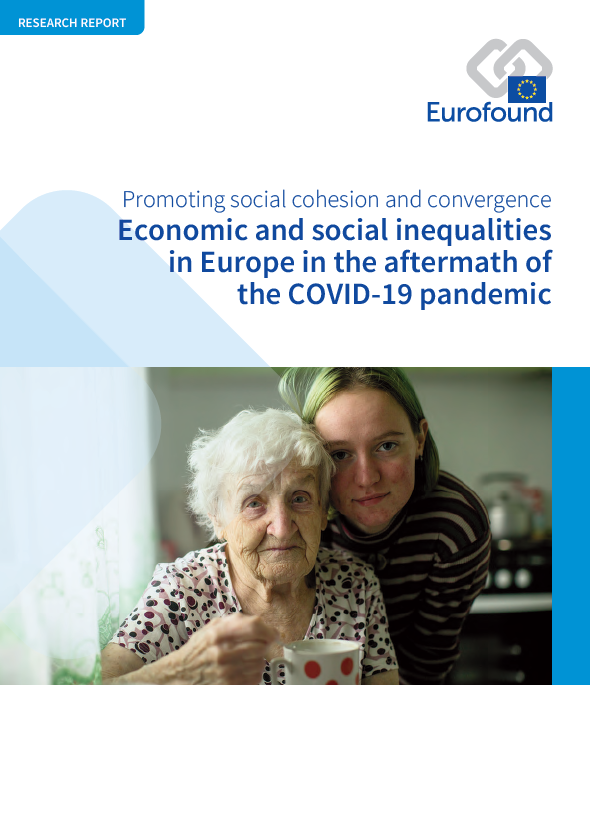
Pandemie covidu-19 měla na jednotlivé sociální skupiny různé dopady, a to v závislosti na stávajících znevýhodněních, přičemž panovalo všeobecné přesvědčení, že v nejrůznějších oblastech života vyvolala nárůst nerovností. Tato zpráva pomocí ukazatelů rámce pro sledování vícerozměrné nerovnosti v EU (MIMF) objasňuje, jak se změnila nerovnost v oblasti příjmů, zdraví, zaměstnanosti a vzdělávání mezi roky 2010 a 2020. Zkoumá rovněž hlavní hybné síly této změny během pandemie a také souvislosti mezi nerovnostmi a vládními politikami v několika oblastech.
Key findings
V prvním roce krize související s covidem-19 pokračoval pokles příjmové nerovnosti, což potvrzovalo vyrovnávání nerovnosti v EU. Uchazeči o zaměstnání a osoby s nízkou a střední úrovní vzdělání však během pandemie s největší pravděpodobností zaznamenaly pokles příjmů, což poukazuje na skutečnost, že i když se příjmová nerovnost během pandemie covidu-19 celkově nezvýšila, pro tvůrce politik bude zásadní, aby tuto situaci v současné krizi související s vysokými životními náklady pozorně sledovali.
Nerovnosti v oblasti zdraví a v oblasti příjmů spolu úzce souvisí, přičemž u osob v nejnižším příjmovém kvintilu je téměř třikrát vyšší pravděpodobnost, že budou mít zdravotní postižení, než u osob z nejvyšší příjmové skupiny (horních 20 %). Během pandemie se rovněž zvýšila nerovnost v přístupu ke zdravotním službám v závislosti na výši příjmů: v roce 2020 bylo riziko neuspokojených léčebných potřeb pro osoby v nejnižším příjmovém kvintilu 5,4krát vyšší než u osob z nejvyšší příjmové skupiny, což poukázalo na skutečnost, jak politiky zaměřené na snižování příjmových nerovností mohou snížit rovněž nerovnosti v oblasti zdraví.
Ze zjištění vyplývá, že práce z domova během pandemie mohla vytvořit nerovnosti mezi skupinami s nízkými a vysokými příjmy, kde se jako zranitelnější vůči krizím jeví pracovníci se smlouvami na dobu určitou, mladí lidé a osoby s nejistým zaměstnáním. Aby se zajistilo, že ve stále flexibilnějším světě práce po pandemii covidu-19 toto nebude pokračovat, bude velmi důležité, aby tvůrci politik řešili otázku nejistého zaměstnání a zvýšili transparentnost a předvídatelnost pracovních podmínek.
Během pandemie bylo odpovídající vybavení pro on-line učení důležitější než příjmy, což poukázalo na důležitost řešení digitální propasti a přístupu k technologiím pro všechny v dlouhodobém horizontu. U rodičů a studentů žijících ve venkovských oblastech, kteří během tohoto období nemuseli dojíždět, byla vyšší pravděpodobnost spokojenosti s kvalitou on-line školní docházky nebo vzdělávání než u rodičů a studentů žijících ve městech.
Způsobilost či nezpůsobilost pracovat z domova vytvářela nerovnosti mezi skupinami s nízkými a vysokými příjmy a zvýraznila genderové rozdíly v oblasti péče o děti a domácí práce. V roce 2020 byla u matek samoživitelek vyšší pravděpodobnost, že si vzhledem k uzavření škol a zařízení péče o děti zkrátí pracovní dobu – pokud ženy i nadále odpracují více hodin neplacené péče než muži, může to potenciálně zvětšit rozdíly v odměňování žen a mužů během oživení.
The report contains the following lists of tables and figures.
List of tables
Table 1: Indicators selected for the income inequality analysis
Table 2: OLS regression model exploring the relationship between government spending and inequality in making ends meet according to education level
Table 3: Panel OLS regression exploring general drivers of income inequality (1995–2020), EU27
Table 4: OLS regression model exploring drivers of income inequality between rural and urban households
Table 5: OLS regression model exploring income inequality by individual characteristics
Table 6: Logistic regressions on income inequality by individual characteristics
Table 7: Indicators selected for the health inequality analysis
Table 8: OLS regression model exploring the relationship between government expenditure and inequality in chronic disease
Table 9: Multilevel logit regression model on worsening health between 2019 and 2020
Table 10: Multilevel logit regression models on worsening health and mental health between 2019 and 2020
Table 11: Indicators selected for the employment inequality analysis
Table 12: OLS regression model exploring the relationship between government expenditure and inequality in opportunity in having a white-collar job
Table 13: OLS regression model exploring the relationship between gender inequality in occupations, childcare and paid leave at country level
Table 14: OLS regression model exploring the relationship between gender inequality in being employed, childcare and paid leave at country level
Table 15: Random effects within–between model showing the relationship between gender inequality in employment, over time and between countries
Table 16: Multilevel linear regression model on the number of hours worked in 2019 and 2020
Table 17: Multilevel linear regression model on the change in the number of hours worked between 2018 and 2019 and between 2019 and 2020
Table 18: Indicators selected for inequality in education analysis
Table 19: OLS regression model exploring the relationship between government spending and inequality in PISA scores
Table 20: Determinants of respondents’ satisfaction with the quality of their children’s online schooling (multilevel ordered logit model)
List of figures
Figure 1: Dimensions of life of the EU MIMF
Figure 2: Intersectional approach to effects of COVID-19 on inequality
Figure 3: Macro-, meso- and micro-level factors in income inequality during the COVID-19 pandemic
Figure 4: Heatmap showing the results of income inequality indicators by country, 2018–2019, EU27 and the UK
Figure 5: Income quintile share ratio (S80/S20) for equivalised disposable income, EU27
Figure 6: Gini coefficient of equivalised disposable income, EU27, Bulgaria, Greece and Poland
Figure 7: Odds ratio of a household having problems making ends meet (with versus without a tertiary education, 2018) against spending on education (2015, % of GDP), EU27 and the UK
Figure 8: Odds ratio of a household having problems making ends meet (with versus without a tertiary education, 2018) against spending on social protection (2015, % of GDP), EU27 and the UK
Figure 9: Scatterplot of government spending on social protection (% of GDP at time t–1) relative to the Gini index of disposable income at time t (1995–2020), EU27
Figure 10: Odds ratio of households having problems making ends meet (rural versus urban, 2018) against public investments in agricultural R&D (2015, % of GDP), EU27 and the UK
Figure 11: Households that reported that their income decreased in 2020 compared with the previous year by country (%), selected Member States
Figure 12: Households containing people aged 50+ that received financial support from the government due to the pandemic by country (%), selected European countries
Figure 13: Recipients of pandemic-related government support by country, EU27 (%)
Figure 14: Macro-, meso- and micro-level factors in health inequality during the COVID-19 pandemic
Figure 15: Heatmap presenting the results of health inequality indicators, 2018–2019, EU27 and the UK
Figure 16: Map of odds ratios of people reporting unmet medical care needs (women versus men, adjusted), 2018
Figure 17: Heatmap of odds ratio of feeling depressed for different social groups, 2018–2019, EU27 and the UK
Figure 18: Risk ratios of having a severe long-standing limitation in usual activities (disability) due to a health problem for various social groups (2010–2020), EU27
Figure 19: Risk ratios of having an unmet medical need due to high cost, distance to travel or waiting lists for various social groups (2010–2020), EU27
Figure 20: Government spending on education in 2002 (% of GDP) relative to ex ante inequality of opportunity in having two or more chronic diseases in 2019 (aged 50+), EU27
Figure 21: Macro-, meso- and micro-level factors in inequality in working life outcomes during the COVID-19 pandemic
Figure 22: Heatmap showing results of working life inequality indicators, 2018–2019, EU27 and the UK
Figure 23: Risk ratios of gender inequality in various dimensions of working life (2002–2020), EU27
Figure 24: Risk ratios of unemployment rates among various social groups (2002–2020), EU27
Figure 25: Risk ratios of employment rates among various social groups (2002–2020), EU27
Figure 26: Odds ratio of women being in employment versus men (2019) against the share of children under three years of age in formal childcare (2019, %), EU27
Figure 27: Average number of weekly hours worked in 2020 by country and contract type, selected EU Member States
Figure 28: Proportion of women who held second or third jobs by household type, 2020 (%)
Figure 29: Macro-, meso- and micro-level factors in inequality in education and learning during the COVID-19 pandemic
Figure 30: Heatmap showing results of education inequality indicators, 2018–2019, EU27 and the UK
Figure 31: Difference in tertiary education attainment as a whole in 55- to 74-year-olds and those with parents with a lower than tertiary education (2021)
Figure 32: Trends regarding inequality in education between women and men (2002–2020), EU27
Figure 33: Risk and odds ratios of NEET rates between various social groups (2004–2020), EU27
Figure 34: Government spending on education (2013, % of GDP) against P90/P10 PISA scores in mathematics (2018), EU27 and the UK
Figure 35: Parents’ satisfaction with the quality of online schooling for their children, EU27 (%)
Figure 36: Parents’ satisfaction with the quality of their children’s online schooling depending on whether they worked from home or not during the pandemic, EU27 (%)
- Number of pages
-
102
- Reference nº
-
EF22002
- ISBN
-
978-92-897-2309-1
- Catalogue nº
-
TJ-07-23-019-EN-N
- DOI
-
10.2806/439913
- Permalink
Cite this publication
Eurofound (2023), Economic and social inequalities in Europe in the aftermath of the COVID-19 pandemic, Publications Office of the European Union, Luxembourg.
